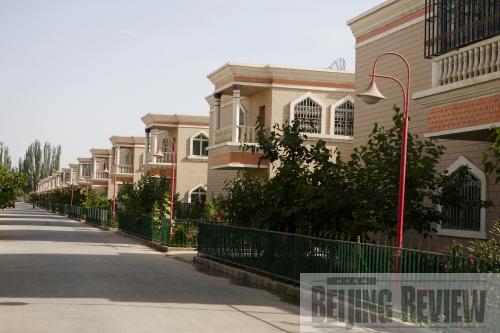|
 |
|
NEW HOMES: Dolan New Village, Iganqi Township of Aksu City. More and more farmers in Xinjiang are moving into earthquake-resistant houses (CHEN JIAN) |
In addition to expanding the growing acreage of fruits, Xinjiang is also improving growing practices and developing deep processing methods. For example, in Hotan County, Hotan Prefecture, walnut farmers began to develop close planting in 1998 under the guidance of two specialists from the autonomous region's academy of forestry science. According to Hou Jianxin, Party secretary of the county, farmers can now grow 420 walnut trees in each hectare of land, whereas before the number was between 90 and 105. In the meantime, farmers are also intercropping fruits with grain. "Fruit trees can increase farmers' incomes while grain can feed them," said Hou. According to him, besides selling original products, the county is also developing deep processing of walnuts, such as walnut powder, walnut candies, walnut oil and walnut capsules.
Safer houses
At 6:33 a.m. on March 21, 2008, a 7.3-magnitude earthquake hit Hotan. The earthquake was clearly felt in several surrounding counties, but no one died. From February 2005 to October 2008, seven earthquakes of magnitudes from 5.7 to 7.3 shook Xinjiang, but caused no injuries or deaths.
That is thanks to a policy carried out in Xinjiang: In February 2004, Xinjiang began the project of earthquake-resistant houses, with the aim of improving the earthquake-resistant qualities of all the houses in the region by means of reinforcement or reconstruction. Xinjiang is a region with a high incidence of earthquakes, but before 2004, due to economic and technical reasons, most houses in rural areas were unable to withstand them.
According to figures from the Construction Department of Xinjiang Uygur Autonomous Region, by the end of 2008, the region had built or reinforced earthquake-resistant homes for 1.9 million families, of which 1.52 million were in rural areas. A total of 41.2 billion yuan ($6.03 billion) was invested in the project.
When implementing the project, many local governments also promoted new countryside construction in light of local conditions.
In the yard of Iminjan Suti, who lives in Baxguja Village of Lop County, Hotan Prefecture, there is a two-room house that is earthquake-resistant, an independent toilet, an independent shower room and a warm livestock pen for 10 sheep and 20 chickens. Tap water and methane are also available in the yard.
Yang Weifeng, Party secretary of Lop County, summarized the characteristics of new countryside construction in the county: There is asphalt road in every village, houses stand along the road and canals run in front of houses. Every courtyard undergoes the "four conversions," which are converting aqua-privy latrines into flush toilets, switching from firewood to methane, converting livestock pens into warm pens and improving the environment of the courtyard.
Lower medical expenses
Zulpiya is a pregnant woman who lives in Layka Township of Hotan County. On May 18, she went to the township health care center for a prenatal examination. She received an ultrasound examination, and the doctor gave her two kinds of medicine. For all this, she only had to pay 10 yuan ($1.46) from her family's account in the rural cooperative medical system.
By now, more than 10 million farmers and herdsmen in Xinjiang enjoy the same benefits. According to figures from the Health Department of Xinjiang Uygur Autonomous Region, since the rural cooperative medical system was introduced in 2003, the system has covered all 89 counties and districts in Xinjiang that are incorporated in the system. About 10.05 million farmers and herdsmen in Xinjiang have participated in the rural cooperative medical system, accounting for more than 94 percent of the region's total population of farmers and herdsmen.
Kasimjan, Director of the Health Bureau of Yakan County, Kashgar Prefecture, told Beijing Review that without the rural cooperative medical system, farmers and herdsmen had to pay for medical services themselves. Now they only pay 10 yuan per year per person, plus a 90-yuan subsidy ($13.18) from the Central Government and the government of the autonomous region. Farmers and herdsmen can get additional medical expenses reimbursed up to 90 percent.
According to provisions of the Health Department, participants in the rural cooperative medical system are reimbursed for no less than 85 percent of their medical expenses incurred at township health care centers; no less than 65 percent at county-level hospitals; no less than 55 percent at prefecture-level hospitals and no less than 50 percent at autonomous region-level hospitals.
Since the government subsidizes most medical expenses and participants only pay a small amount, farmers and herdsmen in Xinjiang are highly motivated to participate in the rural cooperative medical system, which also promotes infrastructure construction in grass-roots medical institutions and improves medical service in rural and pastoral areas. |
